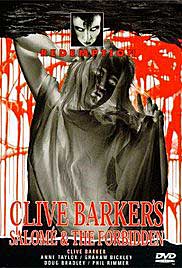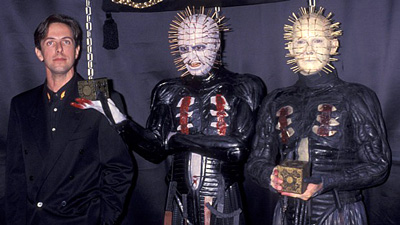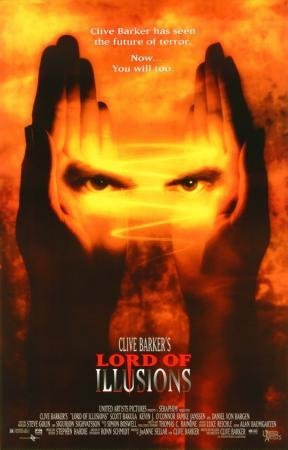Remember Clive Barker? You know, the onetime “future of horror?”
Barker made his name back in the mid-eighties with the still-unsurpassed BOOKS OF BLOOD multi-volume anthology, but his output has grown a mite erratic. Barker’s talent is still evident in (comparatively) recent novels like COLDHEART CANYON and the ABARAT trilogy, but they lack the transcendent impact of his early work, which in addition to the BOOKS OF BLOOD includes triumphs like THE DAMNATION GAME, WEAVEWORLD and THE GREAT AND SECRET SHOW. Since then he’s also largely abandoned the genre that made him famous.
But that’s only in the literary sphere. Barker has remained active in Hollywood as a producer, on CANDYMAN, GODS AND MONSTERS, SAINT SINNER and THE MIDNIGHT MEAT TRAIN. Many of those films were adapted from Barker’s own fiction, and, unlike his recent novels, are all horror-related. However, these films lack one crucial component of the Barker lexicon: they were directed by other people.
Many of those films were adapted from Barker’s own fiction, and, unlike his recent novels, are all horror-related. However, these films lack one crucial component of the Barker lexicon: they were directed by other people.
Let’s not forget that Clive Barker started his film career as a writer-director, and as such completed three feature length films before apparently swearing off the job for good. Barker wasn’t a great director by any means, lacking the seemingly natural skill he demonstrated as a writer, but he did show promise. We’ll never know what might have occurred had Barker continued to hone his directorial skills, but the trajectory of the films he helmed does seem to provide a good indicator.
Barker wasn’t a great director by any means, lacking the seemingly natural skill he demonstrated as a writer, but he did show promise.
Barker’s earliest filmmaking efforts actually date back several years before his debut feature HELLRAISER. I’m referring to two spare, taboo-breaking black-and-white shorts, filmed back in the late seventies and completed in 1998 (when they were released video and DVD by Redemption Films).
SALOME was the first of those shorts. It was apparently based on Oscar Wilde’s classic of the same name, but I couldn’t tell. For that matter, it’s difficult to discern just what the hell is happening from one moment to the next. There’s a woman wandering through dark interior landscapes (looking like nothing so much as somebody’s hallway) and meeting up with a freaky dude. Dull.
THE FORBIDDEN is something else entirely. Exhibited entirely through negatively processed film, it’s a dark and hypnotic variant on themes that would come to define HELLRAISER. It features a man (longtime Barker cohort and future HELLRAISER 2 scribe Pete Atkins) putting together a kind of abstract puzzle and entering a world where naked angels frolic (including Barker himself, who sports a massive erection). The dude eventually gets his skin peeled from his body in an agonizingly drawn-out sequence, and ends up wandering around skinless. The film overall has many of the annoyances of the previous work but is a worthy entry in Barker’s oeuvre, containing all the passion and grotesquerie we’ve come to expect, but with a powerfully surreal air that suggests a new and intriguing path.
SALOME & THE FORBIDDEN (Shorts)
From there we advance to 1987’s HELLRAISER. Adapted from Barker’s novella THE HELLBOUND HEART, it was Clive Barker’s first stab at helming an honest-to-goodness movie, and is probably his best work in the medium. The imaginative storyline and stylish direction occasionally recall Barker’s prose, particularly in the early scenes that introduce the long-simmering passions of an outwardly normal family and a perv named Frank. The thrill-seeking Frank has gotten in touch with a band of freaks called Cenobites, who’ve dragged him down to Hell.
But there’s a way for Frank to get back to our plane. This involves the drinking of blood, which the horny family matriarch (Clare Higgins), hotly anticipating fucking Frank’s re-animated form, is only too happy to provide. Called by one critic “a Hammer remake of SALO,” HELLRAISER is a wonderfully gory and intense work, though marred by a too-obvious low budget, much bad acting (particularly by the attractive but woefully untalented Ashley Laurence as Higgins’ grown daughter) and a seriously lame finale that utilizes hand-animated laser beams.
HELLRAISER 2: HELLBOUND followed in 1988. It’s a worthy sequel, but wasn’t directed by Barker, and so won’t be discussed here. Instead I’ll move on to the controversial NIGHTBREED (1990), Barker’s subsequent effort as writer-director.
I know a lot of you love this film, but I found it a bust. Barker was adapting his BOOKS OF BLOOD novella CABAL, which was nothing special in its original form. NIGHTBREED fails to improve matters. CABAL may be far from Barker’s best work, but does at least contain the sinuous prose and dark imagination that made his name. This movie version reduces the tale to a tacky and chaotic eighties horror fest with Craig Sheffer and Anne Bobby as the blandest leads imaginable.
The simplistic narrative has Sheffer dreaming of a mythic city where monsters live, much to the consternation of his girlfriend (Bobby). Sheffer finds the place, located beneath a graveyard, with remarkable ease, and eventually joins the many freaky critters subsiding there. But a gang of rednecks, led by a psychiatrist serial killer, arrive to screw everything up. David Cronenberg lends some much-needed creepiness as the psychotic shrink, but like most everything else in this film he ultimately gets lost in all the tumult.
Barker has claimed for years that NIGHTBREED was butchered by Morgan Creek Productions, which I fully believe (judging by how they carved up William Peter Blatty’s EXORCIST 3). A director’s cut was released in 2014 that restores around 40 minutes of new footage; it’s an improvement over the previous release, but the film’s underlying problems are still painfully evident.
LORD OF ILLUSIONS, from 1995, was Clive Barker’s next outing as a writer-director. It’s the most ambitious of Barker’s self-directed films, and was greeted with a massive amount of advance publicity on the horror circuit. Barker himself hyped the film mercilessly at various conventions, repeatedly promising the type of complex, character-based genre picture that had fallen out of favor in the mid-nineties.
LORD OF ILLUSIONS isn’t especially bad, but fails to live up to Barker’s grandiose promises. Like NIGHTBREED before it, the film is cluttered, looks cheesy, and indulges in the type of fake scares common to Hollywood horrors but utterly foreign to Barker’s elegant and poetic writing. At least he keeps the weirdness and gore at respectable levels, giving us a veritable five-course meal of grue.
As for the plot, it’s obnoxiously complicated, involving private dick Harry D’Amour (a so-so Scott Bakula) getting drawn into the realm of a psychotic illusionist by an alluring woman (Famke Janssen, who’s absurdly overdressed throughout). We get to see dweebs kneeling on broken glass, a dude pierced by falling swords, folks buried alive in concrete, a brain exploding inside a skull, skin flayed from a body, a dead baby on the floor (which MGM tried to make Barker cut out), and so and so on. None of it is terribly memorable, but Barker does showcase a more confident sense of style and atmosphere; for all its imperfections the film has a hallucinatory intensity that would seem to portend a promising directorial future.
Unfortunately that future has yet to arrive. Not only were there no further cinematic exploits of Harry D’Amour (as Barker once promised there would be), but Harry’s creator hasn’t directed another movie since (he was at one point set to direct something called TORTURED SOULS: ANIMAE DAMNATAE, but that never came to fruition). Let’s hope further Barker directed films materialize, because thus far his filmography feels unfulfilled and incomplete, to say the least.
See Also The Scarlet Gospels




